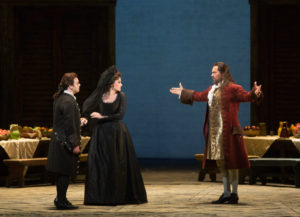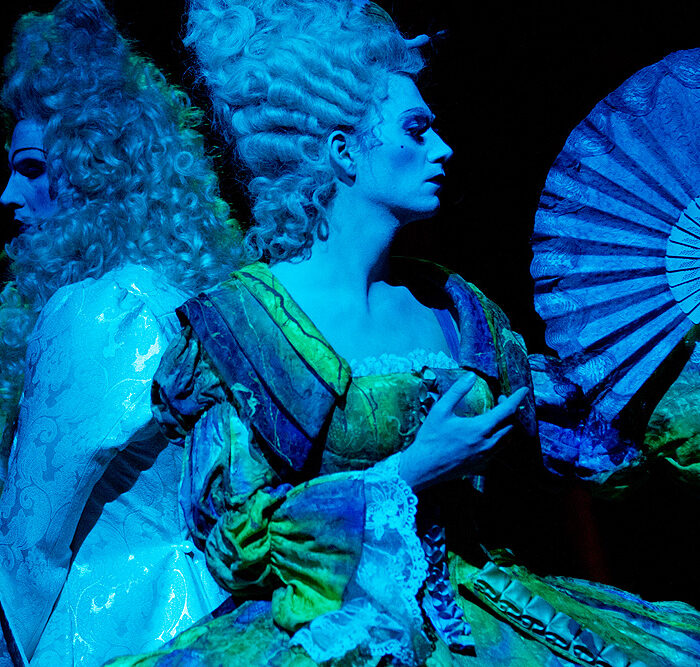
Opera Profile: Mozart’s Genre-Shifting ‘Don Giovanni’
By David SalazarWhen many people think of opera, Mozart’s “Don Giovanni” is undeniably one of the first ones to come to mind.
The work, which premiered aptly on Oct. 29, 1787, is perfect for the Halloween spirit with its shapeshifting nature and its blend of numerous genres. It’s opening notes frighten, but before long the work moves from a drama about sexual abuse with highly comedic elements. The tone is as elusive as its title character, making it one of the richest and most complex operas ever created.
This is the second opera that Mozart worked on with Lorenzo da Ponte, and while many might state that “Le Nozze di Figaro” is the greater opera, “Don Giovanni” remains the most popular and amongst the most-produced in the entire canon.
Short Plot Summary
Leporello waits for his master Don Giovanni to have a sexual encounter with Don Anna. It goes wrong when she resists him and her father, the Commendatore, comes to her aid. In a duel, Giovanni kills the Commendatore and runs off with Leporello.
Donna Anna makes her fiancé Don Ottavio promise to help her get revenge.
Donna Giovanni is found out by his former lover Donna Elvira, who has been looking for her since he abandoned her. He runs off and Leporello explains to her that the Don has had his fair share of conquests and that she was just another number in his book.
At a peasant wedding, Don Giovanni manages to steal away the bride-to-be Zerlina while Leporello takes the prospective groom Masetto and the other guests to his master’s castle.
Don Giovanni attempts to woe Zerlina, but Elvira shows up and stops him in his tracks. Zerlina escapes and when Don Ottavio and Anna show up, Anna recognizes Don Giovanni as the man who attempted to rape her (she hadn’t seen him at the beginning).
At Don Giovanni’s castle, Anna, Elvira, and Ottavio arrive as masked guests and stop the Don when he attempts to rape Zerlina. But he runs off with Leporello.
Giovanni decides that he wants to woe Elvira’s maid and has Leporello pose as him to lure away his former lover so he can make a move on the servant.
Masetto shows up seeking out Giovanni, who is disguised as Leporello. He misguides Masetto’s troupe and beats the peasant when the two are alone. Zerlina comes to her lover’s aid after Giovanni runs off.
Meanwhile, Leporello is found out by the rest of the main characters; he escapes and the others contemplate the circumstances.
At a graveyard, Giovanni invites the ghost of the Commendatore to have dinner with him. The ghost appears and offers Giovanni redemption if he will apologize for his ways. The Don does not accept and is dragged to hell. The other main characters emphasize that every bad person will get his due at some point or another and plan for their respective futures.
Notable Musical Numbers
Practically every aria in this opera is iconic outside of its context. Whether it be the duet “Là ci darem la mano,” or Leporello’s “Madamina, il catalogo è questo” or Donna Anna’s “No mi dir” or Don Ottavio’s “Il mio tesoro,” there is no aria or passage that isn’t beloved by audiences (trust me, this brief list misses a ton of notable arias or numbers.)
It is one of the reasons why this opera is so prominent in the repertoire.
But some passages really stand out, including the overture, which connects right into the opening of Act one; this is in opposition to contemporary practices that had the overture as a self-contained piece. Moreover, the overture is a very testament to the opera’s own hybrid style, its opening passage exploring a dark and dreary world before giving way to something lighter and “more fun.”
The final confrontation between Don Giovanni and the Commendatore is one of the most famed in opera history, bringing back the prominent opening notes of the overture and showcasing Mozart at his most brilliant harmonically.
Watch and Listen
Here is Herbert Von Karajan’s famed production, which stars Samuel Ramey and Anna Tomowa-Sintow, among others.
Categories
Opera Wiki

